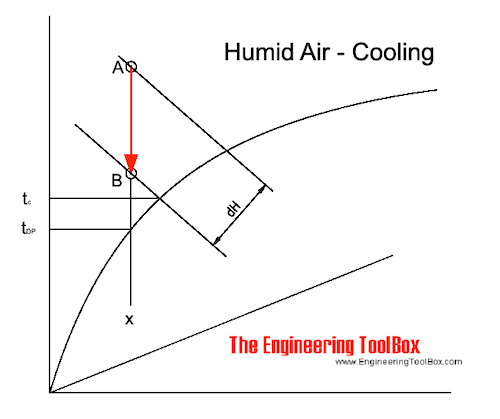Moist Air - Cooling and Dehumidifying
Cooling and dehumidifying processes of moist and humid air - sensible and latent cooling.
When cooling air - part of the energy is used to separate the water (latent heat), and the rest is used to lower the air temperature (sensible heat).
Cooling Moist Air - Sensible Cooling
If the temperature on a cooling surface - tC - is above or equal to the dew point temperature - tDP - of the surrounding air, the air will be cooled without any change in specific humidity. It is Sensible Heat - the "temperature heat" - in the air that is removed.
The air cools along a constant specific humidity - x - line as indicated in the Mollier diagram below:

The process is very similar (opposite direction) to the sensible heating process and the heating formulas can be adapted to calculate change in enthalpy and temperature.
Note! The specific humidity is constant but the relative humidity will increase.
Dehumidifying Moist Air - Latent Cooling
If the temperature on a cold surface is lower than the dew point temperature - tDP - of the humid air, vapor in the air condensates on the surface. Latent heat - vapor - is removed from the humid air.
This process is indicated in the Mollier diagram as below. The air cools in the direction of point C, which is the intersection point of the cold surface temperature (the cooling surface dew point temperature or the apparatus dew-point - tADP) and the saturation line.

With a cold surface of unlimited size and a very small amount of air, it would be possible to reach point C. In the real world a limited surface is never 100% effective and the final state of the cooled and dehumidified air will be somewhere on the straight line between point A and C - point B.
The amount of condensated vapor will be the difference in specific humidity xA - xB.
Note! This process decreases the specific humidity and increases the relative humidity.
Contact Factor - β
The efficiency of a cooling coil can be expressed with the Contact Factor - β - as
β = (xA - xB) / (xA - xC)
= (hA - hB) / (hA - hC)
≈ (tA - tB) / (tA - tC) (1)
where
β = Contact Factor
x = specific humidity (kg/kg)
h = enthalpy (kJ/kg)
t = temperature (oC)
Bypass Factor - BPF
The Bypass Factor - BPF - (or BF) is also used to express cooling coil efficiency as
BPF = (hB - hC) / (hA - hC)
= (tB - tC) / (tA - tC)
= (xB - xC) / (xA - xC) (2)
where
BPF = Bypass Factor (BF)
The relationship between the Contact Factor and the Bypass Factor can be expressed as
BPF = 1 - β (3)
Heat Flow in a Cooling Coil
The total heat flow rate through a cooling coil can be calculated as
q = m (hA - hB) (4)
where
q = heat flow rate (kJ/s, kW)
m = mass flow rate of air (kg/s)
The total heat flow can be expressed as
qs = v ρ (hA - hB) (4a)
where
v = volume flow (m3/s)
ρ = density of air (kg/m3)
Note! The density of air varies with temperature. At 0 oC and atmospheric pressure the density is 1.293 kg/m3. At 80 oC the density is 1.0 kg/m3.
The total heat flow rate can be split into sensible and latent heat. The sensible heat flow rate can be expressed as
qs = m cp (tA - tB) (4b)
where
cp = 1.01 - specific heat air (kJ/kgoC)
The latent heat flow rate can be expressed as
qs = m hwe (xA - xB) (4c)
where
hwe = water evaporation enthalpy (2502 kJ/kg)
Example - Cooling and Dehumidifying Air
1 m3/s of air at 30 oC (86 oF) and relative humidity 60% (A) is cooled down to 15 oC (59 oF) (B). The surface temperature of the cooling coil is 0 oC (32 oF) (C). The density of the air at 20 oC is 1.205 kg/m3.
In the Mollier diagram the state of the cooled air (B) is in the intersection between the straight line between (A) and (C) and the 15 oC temperature line.

From the Mollier diagram it can be stated that the enthalpy in (A) is 70 kJ/kg, in (B) 38.5 kJ/kg and in (C) 8.5 kJ/kg.
The Contact Factor can be calculated as
β = ((70 kJ/kg) - (38.5 kJ/kg)) / ((70 kJ/kg) - (8.5 kJ/kg))
= 0.51
The total heat flow can be calculated as
q = (1 m3/s) (1.205 kg/m3) ((70 kJ/kg) - (38.5 kJ/kg))
= 38 (kJ/s, kW)
The sensible heat flow can be calculated as
qs = (1 m3/s) (1.205 kg/m3) (1.01 kJ/kg.oC) (30 oC - 15 oC)
= 18.3 (kW)
According the Mollier diagram the specific humidity in (A) is 0.016 kg/kg and in (B) 0.0096 kg/kg and the latent heat flow can be calculated as
qs = (1 m3/s) (1.205 kg/m3) (2502 kJ/kg) ((0.016 kg/kg) - (0.0096 kg/kg))
= 19.3 (kW)
Note! Due to inaccuracies when working with graphical diagrams there is a small difference between the total heat flow and the sum of the latent and sensible heat. Inaccuracies like this are in general within acceptable limits.
A similar cooling and dehumidifying process in the psychrometric chart:
- Transform between Mollier diagram and psychrometric chart




